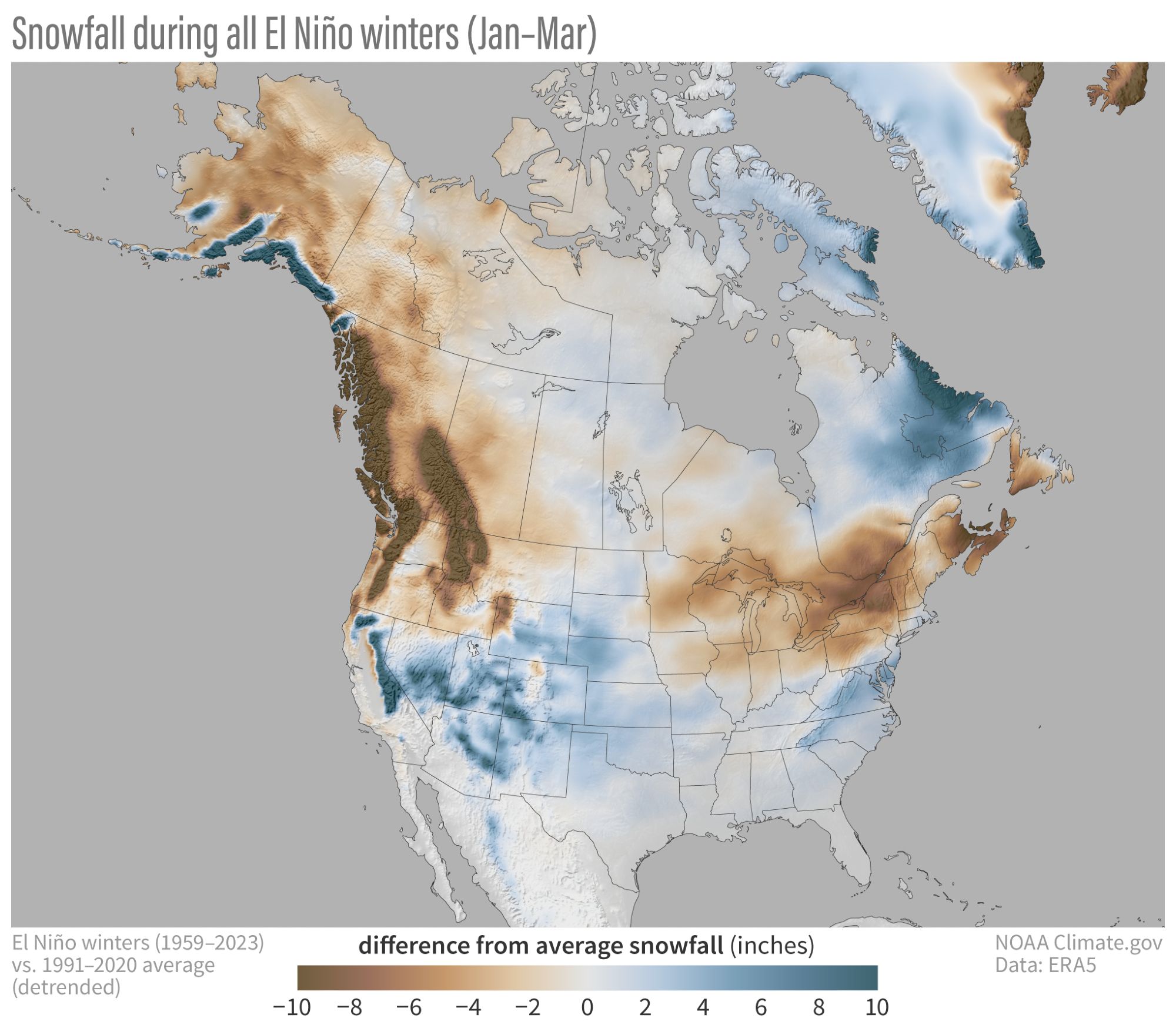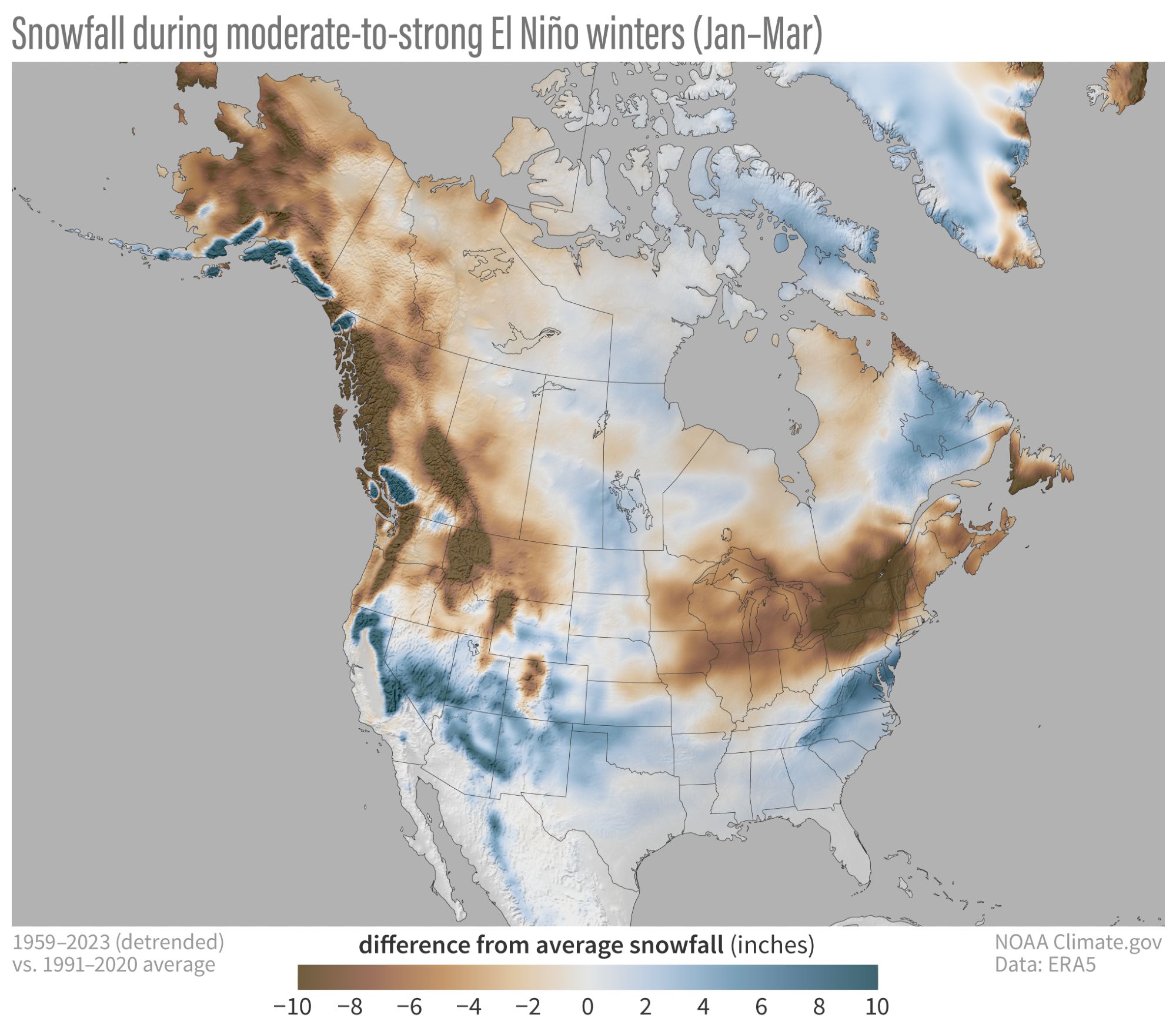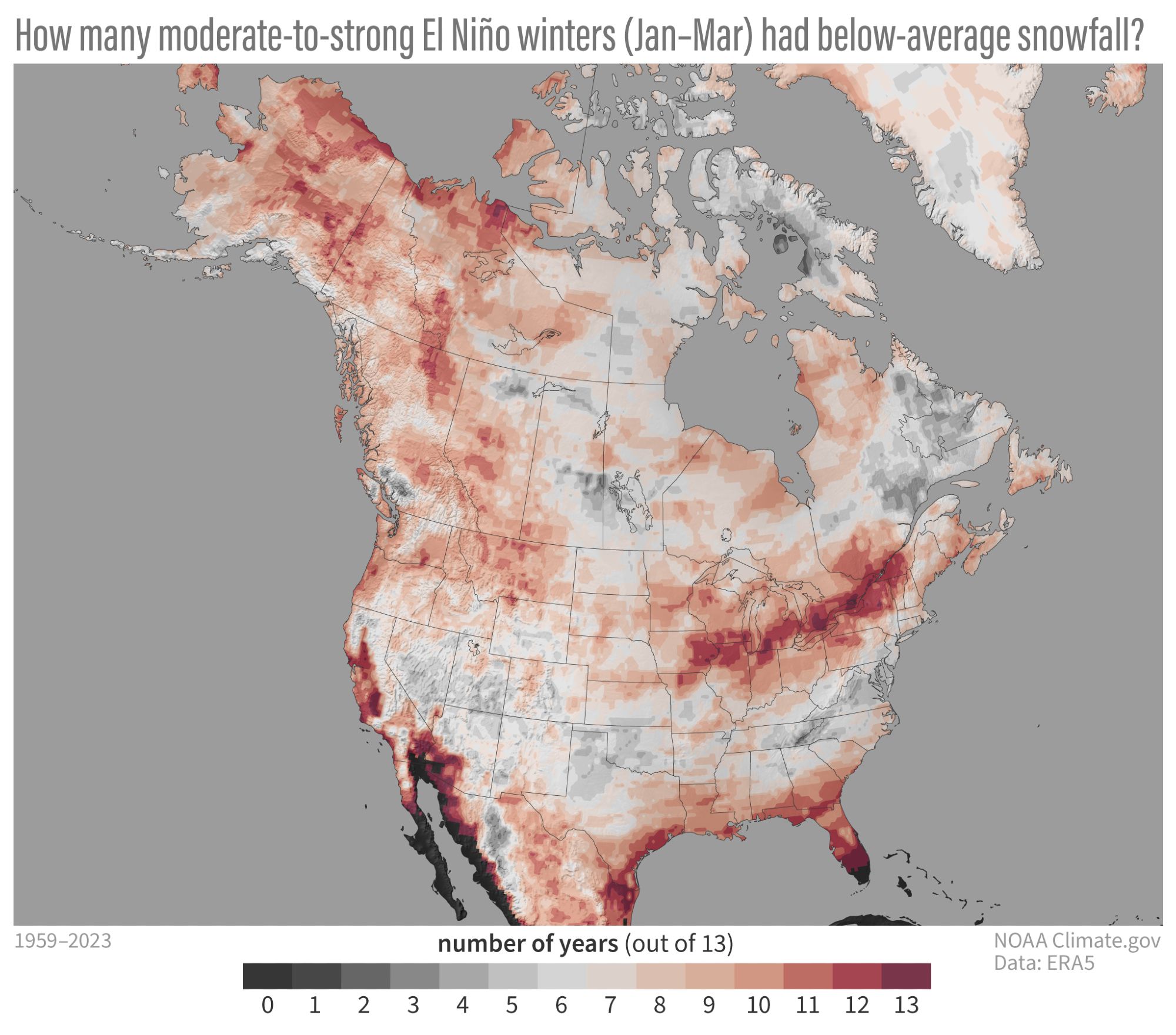Post by Atticus Pizzaballa on Nov 3, 2023 10:32:20 GMT -5
Hey this is not bad for us
CNN
—
As the US gears up for a winter heavily influenced by the first strong El Niño in years, scientists at the National Oceanic and Atmospheric Administration have released maps that offer insight into where snow could pile up.
El Niño – a natural ocean and weather pattern in the tropical Pacific – is forecast to reach the most significant level since a very strong El Niño in 2015-2016 fostered the warmest winter on record across the contiguous US, according to NOAA.
While no two El Niño winters are the same, the pattern typically brings wetter and cooler weather to the southern US while the north becomes drier and warmer. And that’s exactly what’s expected this winter.
However, wetter weather doesn’t necessarily mean more snow. And when it does snow, amounts can vary wildly from one location to the next.
This is where the new maps come in. They show where snow is more or less likely during El Niño winters compared to average.
There’s just one caveat: these maps are historical guidebooks, not forecasts, for how the season’s snow could play out. An actual snowfall forecast would account for a variety of atmospheric and climatological factors, not just El Niño.
“El Niño nudges the odds in favor of certain climate outcomes, but never ensures them,” Michelle L’Heureux, one of the two scientists behind the new maps, explained in a NOAA blog post.

The map above depicts how much snow differs from average across all El Niño winters, regardless of El Niño’s strength. The drier trend that’s typical across the northern US shows up well in the tan and brown shading, while the wetter, snowier trend across the southern US appears in the blue shading.
This pattern comes from the jet stream’s shift south, pushing storms across the southern tier of the country at the expense of the north. And an increase in storms during the winter means snow is more likely.
The stronger an El Niño is, the more amplified its impact becomes. The map below shows the same data for stronger El Niño winters. The pronounced darker hues represent more extreme shifts in snowfall during a strong El Niño compared to an average one.

Snow lovers in the Northwest and Midwest will also have to join their Northeast counterparts in hoping for a big storm. Stronger El Niños have caused less snow than average in the past.

The number of years with below-average snowfall during the 13 moderate-to-strong El Niño winters (January-March average) since 1959. Red shows locations where more than half the years had below-average snowfall; gray shows locations where below-average snowfall happened in less than half the years studied.
Removing snowfall totals from the map and focusing on the number of stronger El Niños with below-average snowfall helps suss out outlier storms.
On the map above, darker reds indicate areas that have experienced more years of below-average snowfall during moderate-to-strong El Niño winters.
Parts of the typically snowy Midwest and Northeast which also suffer from snowfall deficits jump out clearly, a sign that this may be where El Niño steals the most snow, most often.
www.cnn.com/2023/11/03/weather/us-snowfall-maps-el-nino-winter-climate/index.html
We will have to watch this develop this winter.
New maps reveal who could see more snow this winter during a strong El Niño
—
As the US gears up for a winter heavily influenced by the first strong El Niño in years, scientists at the National Oceanic and Atmospheric Administration have released maps that offer insight into where snow could pile up.
El Niño – a natural ocean and weather pattern in the tropical Pacific – is forecast to reach the most significant level since a very strong El Niño in 2015-2016 fostered the warmest winter on record across the contiguous US, according to NOAA.
While no two El Niño winters are the same, the pattern typically brings wetter and cooler weather to the southern US while the north becomes drier and warmer. And that’s exactly what’s expected this winter.
However, wetter weather doesn’t necessarily mean more snow. And when it does snow, amounts can vary wildly from one location to the next.
This is where the new maps come in. They show where snow is more or less likely during El Niño winters compared to average.
There’s just one caveat: these maps are historical guidebooks, not forecasts, for how the season’s snow could play out. An actual snowfall forecast would account for a variety of atmospheric and climatological factors, not just El Niño.
“El Niño nudges the odds in favor of certain climate outcomes, but never ensures them,” Michelle L’Heureux, one of the two scientists behind the new maps, explained in a NOAA blog post.

The map above depicts how much snow differs from average across all El Niño winters, regardless of El Niño’s strength. The drier trend that’s typical across the northern US shows up well in the tan and brown shading, while the wetter, snowier trend across the southern US appears in the blue shading.
This pattern comes from the jet stream’s shift south, pushing storms across the southern tier of the country at the expense of the north. And an increase in storms during the winter means snow is more likely.
The stronger an El Niño is, the more amplified its impact becomes. The map below shows the same data for stronger El Niño winters. The pronounced darker hues represent more extreme shifts in snowfall during a strong El Niño compared to an average one.

Snow lovers in the Northwest and Midwest will also have to join their Northeast counterparts in hoping for a big storm. Stronger El Niños have caused less snow than average in the past.

The number of years with below-average snowfall during the 13 moderate-to-strong El Niño winters (January-March average) since 1959. Red shows locations where more than half the years had below-average snowfall; gray shows locations where below-average snowfall happened in less than half the years studied.
Removing snowfall totals from the map and focusing on the number of stronger El Niños with below-average snowfall helps suss out outlier storms.
On the map above, darker reds indicate areas that have experienced more years of below-average snowfall during moderate-to-strong El Niño winters.
Parts of the typically snowy Midwest and Northeast which also suffer from snowfall deficits jump out clearly, a sign that this may be where El Niño steals the most snow, most often.
www.cnn.com/2023/11/03/weather/us-snowfall-maps-el-nino-winter-climate/index.html
We will have to watch this develop this winter.



